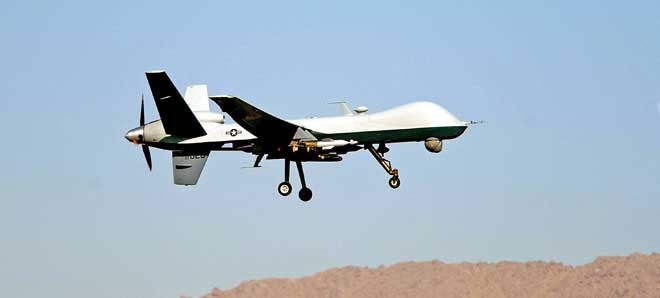

The drone strikes on Waziristan have driven a wedge through an already polarised Pakistani public opinion, highlighting the ambiguity reflected in our perception of nationalism. Many commentators on electronic media subscribe to a certain perception of Islam and pursue it at the expense of our geography. I will address that issue with all its theoretical complexities in this column. In the lines to follow, I will focus on two dimensions of the same issue: the drone and the controversy surrounding it, and the mapping of the phases of its development.
While Malala Yousafzai has been lauded in the West for her courage in espousing the cause of education for girls, the anti-drone campaign has also registered its presence particularly in institutions such as Cambridge University and Kings’ College, London.
The British NGO ‘Reprieve’ is very active in spreading news about the detrimental effects of drone strikes in Waziristan. It also sponsored a US trip of a small girl, Nabila Rehman, affected by drones so that she could draw the attention of American parliamentarians to the disaster that drones have wreaked in the area.
Events to draw attention to the illegality of the use of drones at both Cambridge and Kings’ College were very well-attended, particularly the one at Cambridge University, hosted by the Centre of South Asian Studies with Jemima Khan as the special guest. She was the centre of attention and left a very good impression.
Agreeing that the suicide bombings that have rocked all of Pakistan have no justification, and that drone strikes have killed several terrorists, it was also stressed that one must not ignore the flip side of the narrative which is widely prevalent in the West. While the documentary which was screened did not live up to the expectations of many, Jemima Khan made up for that inadequacy with her presence.
It is important here to mention that a Masters’ student, Sara Aslam, was the main organiser of the event. Prof Christopher Bayly made the introductory remarks while the event was made possible due to the interest and efforts of Barbara Roe and Dr Kevin Greenbank.
The conversations revealed that many of the participants did not have a clear idea of the effects of the use of drones; it is these conversations which prompted me to map the history of drones.
Drones, or unmanned aerial vehicles (UAVS), are aircraft either controlled by pilots from the ground or increasingly following a pre-programmed mission autonomously. The Oxford English Dictionary describes drones as ‘a pilotless aircraft or missile directed by remote control’.
Drones have dozens of different types but basically they fall into two categories; those used for reconnaissance and surveillance purposes and those which are armed with missiles and bombs. In the case of Waziristan, use of the latter category of drones has evoked a lot of concern from various quarters. British and US Reaper and Predator drones have mostly been operating in Afghanistan, Iraq and Waziristan, but they are controlled via satellite from Nellis and Creech USAF base outside Las Vegas, Nevada. On the operational side, one person ‘flies’ the drone, another operates and monitors the cameras and sensors, while a third person is in contact with the "customers": ground troops and commanders in the war zone.
Now we should turn to the phases of its development, which takes us back to August 22, 1849 when the earliest unmanned aerial vehicle for war-fighting was used. Austrians were the first to attack the Italian city of Venice with unmanned balloons loaded with explosives. Some of the balloons were launched from the Austrian ship Volcano. Few of the balloons worked as intended, while others were caught in a change of wind and blown back over Austrian lines.
The first pilotless aircraft was built during the First World War, using A.M. Low’s new radio control techniques in 1916. Soon afterwards on September 12, the Hewitt-Sperry Automatic Airplane, also known as the "flying bomb" made its first flight, demonstrating the efficacy of the concept of unmanned aircraft. It was called the ‘aerial torpedo’ and was an earlier version of today’s cruise missile. Later, in November 1917, the Automatic Airplane was demonstrated to representatives of the US army. When the war came to an end, no further headway was made in this technology.
The first large-scale production of purpose-built drones was the project of a British person named Reginald Denny who migrated to US and, subsequently, became a Hollywood star. He not only made a name for himself in acting, but simultaneously pursued his interest in radio-controlled model aircraft in the 1930s. He was a founder of Reginald Denny Industries.
The gradual evolution in that technology continued through Second World War and subsequently through the cold war. Persistence holds the key in scientific advancement. Investment on research and education is absolutely vital.
To conclude, the first successful experiment of UAVs was conducted by Israelis against the Syrians in 1982. The Americans tested it in 1987 and they were used again in the Balkans in 1995. It was also effectively used in operation Iraqi Freedom. However, the perfection of the technology came in Iraq and Afghanistan. Regrettably, the technological advancement in the West comes at the cost of human life in the non-West.